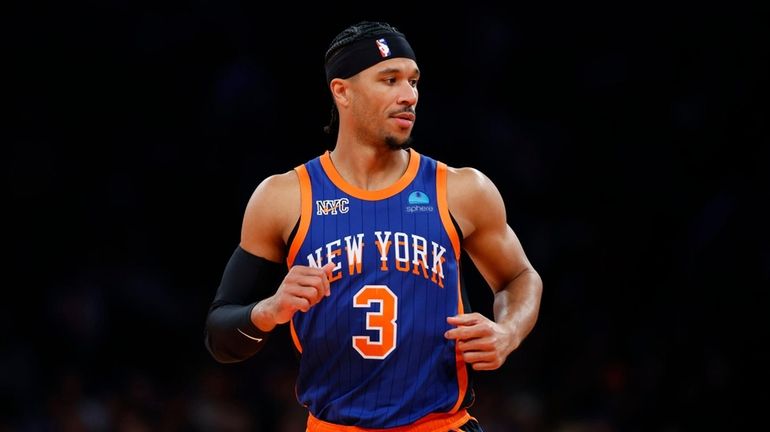Knicks' Josh Hart frustrated but coping with his role on team

Knicks guard Josh Hart (3) during the first half against Charlotte Hornets at Madison Square Garden, in New York, Tuesday, Nov. 28, 2023 Credit: Noah K. Murray
When Josh Hart arrived in New York at the trade deadline last season everything seemed perfect. He fit perfectly with the team, helping a playoff push and winning over the Madison Square Garden crowd with his non-stop hustle and his penchant for delivering a clutch three-point field goal.
A close friend and former college teammate of Jalen Brunson, his play on the court seemed like a fever dream of Tom Thibodeau and off it he was an entertaining sidekick in postgame news conferences.
Only 25¢ for 5 months
When Josh Hart arrived in New York at the trade deadline last season everything seemed perfect. He fit perfectly with the team, helping a playoff push and winning over the Madison Square Garden crowd with his non-stop hustle and his penchant for delivering a clutch three-point field goal.
A close friend and former college teammate of Jalen Brunson, his play on the court seemed like a fever dream of Tom Thibodeau and off it he was an entertaining sidekick in postgame news conferences.
But Monday, he expressed some frustration with his role this season, pinning it as a reason why he has struggled with his shooting this season — his three-point percentage dipping from 51.9% to 28.6%. And after Thibodeau dismissed the complaint Tuesday Hart didn’t back down.
“I’m a rhythm player,” he said in the locker room before the Knicks took on the Charlotte Hornets. “So sometimes if I don't touch the ball for four or five minutes running up and down the floor, just catch and shoot, I might as well be playing with a football.”
Hart was referring to the feel of the ball that sometimes seems like a foreign object when he is suddenly faced with a three-point opportunity. He has actually more shots per game — and more three-point attempts — than he did after joining the Knicks last season. His usage rate is slightly down though.
“There really hasn’t been a change,” Thibodeau said. “To be honest, his usage is up (actually down from 12.6% last year to 11.9). He’s handling the ball more. The way he’s being used is not any different than last year. He’s pushing the ball up in transition. He hasn’t shot the three as well as he did last year. But he’s open, he can’t hesitate. He’s got to shoot it. The most important thing is to be mentally tough, to work through things. I think he’ll be there. He’s a good player.
“Yeah, we’ll go with that,” Hart said when asked about Thibodeau’s comment, pausing for a long time before adding, “I’m a role player in this offense in the league, and sometimes it’s tough to get into rhythm, not just offensively but in general for that role. And I’m cool with that. I’ve got to find ways to be involved and be active and the ball finds energy and has energy, so I’ve just got to make sure I’m doing what I’m supposed to do in terms of energy, rebounding and stuff like that and just finding ways to be effective.”
Hart is not the only one who has had to deal with this situation. With Brunson, Julius Randle, RJ Barrett and Immanuel Quickley taking the bulk of the shots Hart is attempting just 6.8 attempts per game. Quentin Grimes, in the starting lineup, has dealt with the same — taking just 6.4 shots per game with 5.4 per game from beyond the arc.
"It’s tough. I know he’s in a really tough position,” Hart said of Grimes. “Just got to find ways to stay ready, to stay involved, to stay feeling good. I don’t know what’s going on through his mind. That can sometimes be very frustrating. He’s someone who takes the best matchup every game for 82 games. He’s someone who is very durable. That’s tough — especially when you feel like you’re giving everything you have. Just have to find ways to be aggressive, to be involved within the offense, within the system. And just try to make your way.”
The added stress for Hart has been that he has had to serve as the backup power forward at just 6-4, often finding himself defending a player at least six inches taller than himself.
“The thing that I look at is the most important thing is the net rating of the bench unit,” Thibodeau said. “So when you look at those four guys with RJ, it’s a plus-10, that’s at the top of the league. So how’s the group functioning? Put what’s best for the team ahead of any individual stuff, it’s all about the team and sacrificing for the team. What’s changed a little for him maybe is defensively, in terms of he has to guard a big. There are still situations where he’s going to guard the best offensive players. It’s one of his strengths. I want us to take advantage of that. But he can function well with both units. I don’t want him hesitating. If he’s open, shoot the ball."